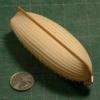-
Posts
13,290 -
Joined
-
Last visited
Content Type
Profiles
Forums
Gallery
Events
Everything posted by druxey
-
Your experiments look very effective, Daniel. Try using acrylic paint with a ruling pen to get the seam doubling with less transparency and see what you think. I've used this very effectively at a much larger scale (1:48) on SilkSpan. One needs to pre-stretch any paper as one would for watercolor paper to avoid sags and wrinkles when wetted. Also, Silkspan won't tear when wet.
-
So nice to see you back and the terrific progress you are making. Interesting shellac/silk technique that you've used, Glenn.
-

ancre Le Fleuron by juzek - 1:27
druxey replied to juzek's topic in - Build logs for subjects built 1501 - 1750
You are moving along there! Looking excellent, Juzek. -
A Forstner drill bit will give smoother cuts, I think.
- 2,625 replies
-
- kaiser wilhelm der grosse
- passenger steamer
-
(and 1 more)
Tagged with:
-
For some reason I've only just stumbled across your log. Very neat work indeed. Please assume a 'like' has been added to every progress report!
- 277 replies
-
- model shipways
- 18th century longboat
-
(and 1 more)
Tagged with:
-
I can only hope that the various forces tending towards warping cancel each other out. If not, you'll have a gondola!
-
Thanks, Wefalck, for your description of Pertinax. All I could find was the Roman emperor of that name!
-
What is Pertinax made of, please? Looks like an interesting and useful material. Nice work!
-
The garboard should not rise up the stem like that. See the planking tutorials (pinned) on this site. Revising this will get rid of those pointy-ended strakes and drop strakes!
- 362 replies
-
- active
- revenue cutter
-
(and 1 more)
Tagged with:
-
I believe that the reef points were a little longer on the aft side of the sail.
-
The other consideration of discontinuous framing without fillers between the frames up to the floorheads was drainage of bilgewater. To pump the ship reasonably dry, holes would need to be cut though the underside of the floors to allow a continuous passage to the bilge pumps. The later system of a passage above the frames would - theoretically, at least - keep the bilge much drier.
-
See also the thread: "Fabric for your sails and where to buy?"
-
Nice to see you back in the shipyard, Remco!
- 1,215 replies
-
- sloop
- kingfisher
-
(and 1 more)
Tagged with:
-
There is nothing wrong with soaking planks, provided you leave adequate time for them to dry out again before final fitting and attachment to the hull. Most of us lack the patience to wait, is the issue!
- 19 replies
-
- separation
- wood movement
-
(and 1 more)
Tagged with:
-

ancre Le Fleuron by juzek - 1:27
druxey replied to juzek's topic in - Build logs for subjects built 1501 - 1750
All those frames hung up like washing on a line! Great progress. -
Allan: I believe that part of the issue with Longridge's Victory model was damp storage underground during WW2, and subsequent drying out in the museum.
- 19 replies
-
- separation
- wood movement
-
(and 1 more)
Tagged with:
About us
Modelshipworld - Advancing Ship Modeling through Research
SSL Secured
Your security is important for us so this Website is SSL-Secured
NRG Mailing Address
Nautical Research Guild
237 South Lincoln Street
Westmont IL, 60559-1917
Model Ship World ® and the MSW logo are Registered Trademarks, and belong to the Nautical Research Guild (United States Patent and Trademark Office: No. 6,929,264 & No. 6,929,274, registered Dec. 20, 2022)
Helpful Links
About the NRG
If you enjoy building ship models that are historically accurate as well as beautiful, then The Nautical Research Guild (NRG) is just right for you.
The Guild is a non-profit educational organization whose mission is to “Advance Ship Modeling Through Research”. We provide support to our members in their efforts to raise the quality of their model ships.
The Nautical Research Guild has published our world-renowned quarterly magazine, The Nautical Research Journal, since 1955. The pages of the Journal are full of articles by accomplished ship modelers who show you how they create those exquisite details on their models, and by maritime historians who show you the correct details to build. The Journal is available in both print and digital editions. Go to the NRG web site (www.thenrg.org) to download a complimentary digital copy of the Journal. The NRG also publishes plan sets, books and compilations of back issues of the Journal and the former Ships in Scale and Model Ship Builder magazines.


